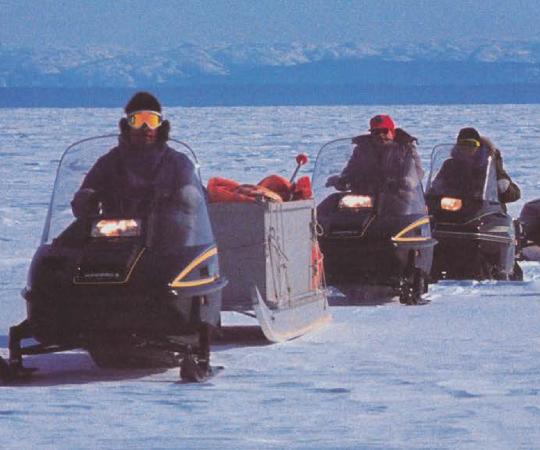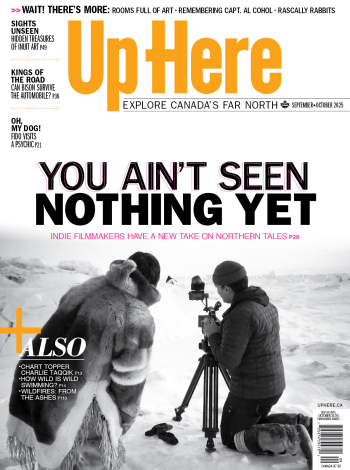It’s off-season. Hotel fronts are missing letters, OPEN signs are unlit. Everything and everyone in this town of 800-or-so seems to be in a perennial state of mid-ness—mid-May, mid-melt, mid-work. Churchill is not quite dead, but it’s close.
I’m mid-journey, having arrived from Rankin Inlet by air to go south by rail some 1,700 kilometres. The train is sitting at the station. I watched it slowly roll into town earlier this morning, and workers are now busy offloading, separating and reconfiguring it. It acts as Churchill’s economic lifeline; an IV dripping beer, milk and travellers into town three times a week. I will be aboard as it slowly rolls out tonight.
With a few hours to while away, I hear a pulse of George Thorogood coming from the Seaport Hotel bar’s ‘dark side’ across the street. Inside, I say to the bartender, “I guess, give me a bourbon, a scotch and a beer.” Three time-keeping devices, I figure, seeing as my watch, cellphone and the bar’s clock all read different times. After downing the drinks, a realization—“Gah! I’m late!” I rush outside in time to see the ass-end of the train slowly pulling away from the station.
I chase after it without thinking, imagining maybe I would Wild-West hop on the caboose. (Wait, there aren’t cabooses anymore.) A VIA porter on the tracks stops me mid-sprint to politely ask what the hell I’m doing. The train was merely repositioning; he hadn’t even unlocked the station door yet.
Catching my breath, I peruse the plaques outside then inside the heritage station, which quadruples as a museum, visitor centre and Parks Canada office. What I surmise is this town always expected to be a major hub and that its rail line would forever remain the fastest way to ship grain from North America to Europe. But time and the global economy have made that assertion dubious.
The same porter opens the doors to the platform and begins to take tickets. “You’ll see the derailment,” says a man going to Dauphin, already taking out his phone to show me pictures. I’d forgotten about the train derailment two summers ago. He tells me he was also a passenger on another train out of Churchill that derailed, stopping at a good shot of the long train car from which he was evacuated. It bridges a gap in the landscape, hanging precariously by only its couplers, without any rails below it.
Because the tracks have fallen into a sort of bearable disrepair, we can only go about 15 kilometres per hour for the first few hundred klicks. I choose to view this lack of speed as a positive. But that doesn’t last for long. I’ve been on lengthy train rides before but this one waddles down the track side-to-side as much as forward.
“You know, some people try to kill time, but time always kills people.”
The handful of train staff equals, or outnumbers, the passengers. One family digs out a cribbage board but gives up teaching their young son, switching instead to Yahtzee. The repetitious chica-chica-chica rattle of die spilling onto their plastic table is akin to psychological torture. I decide now is probably as good a time as any to make use of the one saving grace in this eternal limbo: the bar car. That’s where I meet Tony.
Every few hours we come to a full halt momentarily at crossings named by miles, not even long enough for a cigarette. One or two passengers hop on or off. They ingeniously use the train for grocery shopping, explains Tony over drinks. They’ve parked their snowmobiles at the crossing, jumped on the train for the day, and now their families have come to meet them at the corner of Nowhere and Train Track to help lug all that food home somewhere. Tony’s doing the same thing; he knows the train’s route and schedule by heart and the staff by name. After a while Tony hand-signals a sideways V to one worker who nods back. “Go for a smoke?” he asks, and we head up-train to the cargo car. It is nearly empty and full of dust. Tony pulls the latch on the heavy metal door and slides it open a crack. We sway and stagger a bit as the train ambles along. I remark on how different the world looks with trees after spending so many months in Nunavut. The tree line, for anyone who passes slowly through it, is more of a tree spotting—a freckling of one-sided pines that slowly blends into bigger splotches of spindly pines.
I’m back at my seat and fall asleep. The Yahtzee family wakes me up the next morning. We’re now way past the tree-spotting: we’re in a full-blown endless wood of thinly packed bush. The sun shines warmer and the snow has disappeared. I conked out in winter and woke up in summer. A few poplars have even come out. I examine my hairline in the bathroom mirror to make sure we haven’t gone through a wormhole and all of a sudden I’m 90. But I’m only 14 hours older than when we left Churchill. The train has another day and night to go.
I see Tony again smoking in the cargo car. He makes room at the doorway for me. I ask if he heard the Yahtzee family. He thinks about this and then after a while: “You know, some people try to kill time, but time always kills people,” he says.
“That’s deep,” I say, as the train rolls on.









